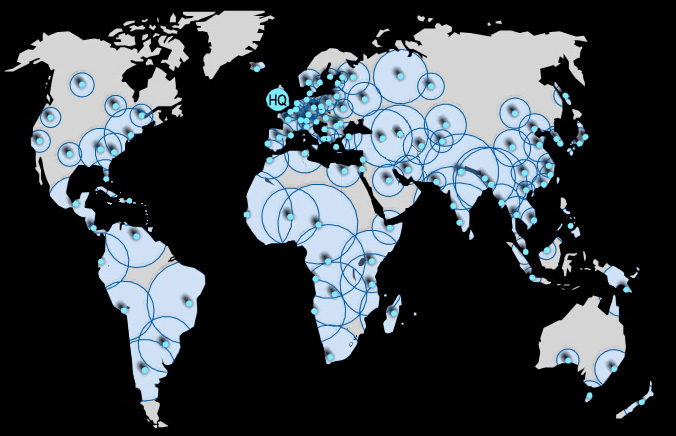While this concept could be applied to a world of diseases, not just AIDS, for the purposes of this project I am focusing on AIDS because only GSK produces AIDS treatment drugs, and this concept is based through that company, which is headquartered in London, England.
I'll start from the largest scale, and work my way down. The HQ of GSK will be an entire city of parts to drug manufacturing plants (located outside of London), to be detached and transported to the manufacturing plants and locations in the map below (from the previous post).

The rings around the plants represent their production capacities based on the demand for AIDS treatment in that region, not the geographic region they serve. Because of the ever-changing world populations, and the spread of AIDS (reaching and affecting new and different populations as time passes, see this animation which maps the history of the virus's spread), these manufacturing plants' capacities will be easily altered by the detachability of and stackability of these resources that come from London.
These plants will subtly infiltrate the cities in which they are located, as shown below (see conceptual collage from previous post). They are subdivided into "wellness pods" which are small pods containing necessities for treating AIDS that can be transported to other cities as well as the most remote of areas. The animation shows one of these pods travelling to a remote area outside of the manufacturing city.
Here are a couple renderings of the system:


For the purposes of this project, I will be zooming in and focusing on Cape Town, South Africa and its surrounding region. One reason I am focusing here is that it is a good example of a town that produces AIDS treatment but sells it elsewhere, so that its own citizens do not receive the treatment (notice that it is not part of the megaContinent). Another reason is that the area that it is not serving has some of the highest prevalence of AIDS in the world, and therefore the highest demand for the drugs.

Here are a couple collages that put the model in the context of Cape Town.


These wellness pods will serve a few functions - one of which will be the transport of drugs, treatment and equipment, particularly to remote areas (shown below).

There is also the possibility of a new way of looking at hospiss care - GSK's wellness pods extending to those who can afford a more comfortable treatment system in their home.



1 comment:
I really like the visuals you've put together so far. working in a small scale on the last images of your post really help put these pods into perspective. I find modularity an interesting idea, simple in a small scale and a capablility of increasing in complexity as the scale increases.
Speaking in a larger scale, you've spoken about London being the hub for all the distribution of medical supplies, so I'm curious how the design reinforces that proposition. Are the products shipped out by plane to each destination, or is there some sort of infrastructure or "highway" for them to travel on independently?
On another note, the objects you've created seem to have an infectious quality, like they've found a host (the building or mountainside) and attached themselves to it. I'm liking it.
Post a Comment